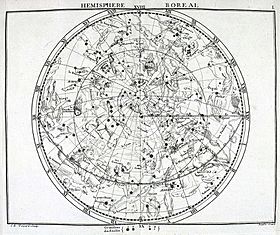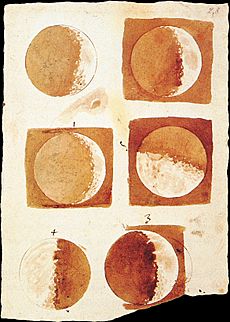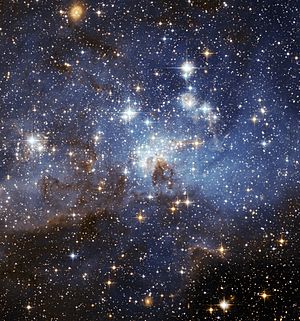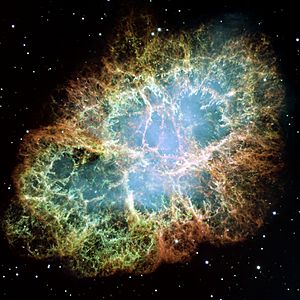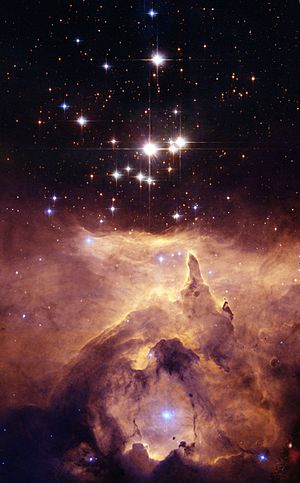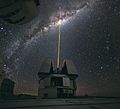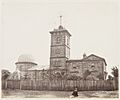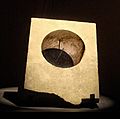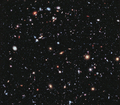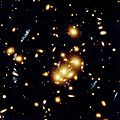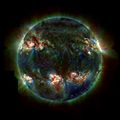Astronomy facts for kids
Astronomy is a natural science. It is the study of everything outside the atmosphere of Earth.
It studies celestial objects (such as stars, galaxies, planets, moons, asteroids, comets and nebulae) and processes (such as supernovae explosions, gamma ray bursts, and cosmic microwave background radiation). This includes the physics, chemistry of those objects and processes.
A related subject, physical cosmology, is concerned with studying the Universe as a whole, and the way the universe changed over time.
The word astronomy comes from the Greek words astron which means star and nomos which means law. A person who studies astronomy is called an astronomer.
Astronomy is one of the oldest sciences. Ancient people used the positions of the stars to navigate, and to find when was the best time to plant crops. Astronomy is very similar to astrophysics. Since the 20th century there have been two main types of astronomy, observational and theoretical astronomy. Observational astronomy uses telescopes and cameras to observe or look at stars, galaxies and other astronomical objects. Theoretical astronomy uses maths and computer models to predict what should happen. The two often work together, the theoretical predicts what should happen and the observational shows whether the prediction works.
Astronomy is not the same as astrology, the belief that the patterns the stars and the planets may affect human lives.
History of astronomy
Ancient
Early astronomers used only their eyes to look at the stars. They used maps of the constellations and stars for religious reasons and also to work out the time of year. Early civilisations such as the Maya people and the Ancient Egyptians built simple observatories and drew maps of the stars positions. They also began to think about the place of Earth in the universe. For a long time people thought Earth was the center of the universe, and that the planets, the stars and the sun went around it. This is known as the geocentric model of the Universe.
Ancient Greeks tried to explain the motions of the sun and stars by taking measurements. A mathematician named Eratosthenes was the first who measured the size of the Earth and proved that the Earth is a sphere. A theory by another mathematician named Aristarchus was, that the sun is in the center and the Earth is moving around it. This is known as the Heliocentric model. Only a small group of people thought it was right. The rest continued to believe in the geocentric model.
Most of the names of constellations and stars that we have, come from Greeks of that time.
Arabic astronomers made many advancements during the Middle Ages including improved star maps and ways to estimate the size of the Earth.
Renaissance to modern era
During the renaissance a priest named Nicolaus Copernicus thought, from looking at the way the planets moved, that the Earth was not the center of everything. Based on previous works, he said that the Earth was a planet and all the planets moved around the sun. This heliocentrism was an old idea. A physicist called Galileo Galilei built his own telescopes, and used them to look more closely at the stars and planets for the first time. He agreed with Copernicus. Their ideas were also improved by Johannes Kepler and Isaac Newton who invented the theory of gravity. At this time the Catholic Church decided that Galileo was wrong. He had to spend the rest of his life under house arrest.
After Galileo, people made better telescopes and used them to see farther objects such as the planets Uranus and Neptune. They also saw how stars were similar to our Sun, but in a range of colours and sizes. They also saw thousands of other faraway objects such as galaxies and nebulae.
Modern era
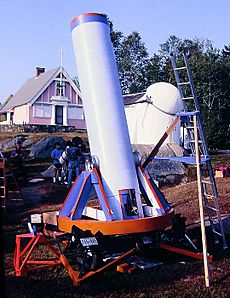
The 20th century saw important changes in astronomy.
In 1931, Karl Jansky discovered radio emission from outside the Earth when trying to isolate a source of noise in radio communications, marking the birth of radio astronomy and the first attempts at using another part of the electromagnetic spectrum to observe the sky. Those parts of the electromagnetic spectrum that the atmosphere did not block were now opened up to astronomy, allowing more discoveries to be made.
The opening of this new window on the Universe saw the discovery of entirely new things, for example pulsars, which sent regular pulses of radio waves out into space. The waves were first thought to be alien in origin because the pulses were so regular that it implied an artificial source.
The period after World War 2 saw more observatories where large and accurate telescopes are built and operated at good observing sites, normally by governments. For example, Bernard Lovell began radio astronomy at Jodrell Bank using leftover military radar equipment. By 1957, the site had the largest steerable radio telescope in the world. Similarly, the end of the 1960s saw the start of the building of dedicated observatories at Mauna Kea in Hawaii, a good site for visible and infra-red telescopes thanks to its high altitude and clear skies. Mauna Kea would eventually come to host very large and very accurate telescopes like the Keck Observatory with its 10-meter mirror.
The next great revolution in astronomy was thanks to the birth of rocketry. This allowed telescopes to be placed in space on satellites.
Satellite-based telescopes opened up the Universe to human eyes. Turbulence in the Earth's atmosphere blurs images taken by ground-based telescopes, an effect known as seeing. It is this effect that makes stars "twinkle" in the sky. As a result, the pictures taken by satellite telescopes in visible light (for example, by the Hubble Space Telescope) are much clearer than Earth-based telescopes, even though Earth-based telescopes are very large.
Space telescopes gave access, for the first time in history, to the entire electromagnetic spectrum including rays that had been blocked by the atmosphere. The X-rays, gamma rays, ultraviolet light and parts of the infra-red spectrum were all opened to astronomy as observing telescopes were launched. As with other parts of the spectrum, new discoveries were made.
From 1970s satellites were launched to be replaced with more accurate and better satellites, causing the sky to be mapped in nearly all parts of the electromagnetic spectrum.
Discoveries
Discoveries broadly come in two types: bodies and phenomena. Bodies are things in the Universe, whether it is a planet like our Earth or a galaxy like our Milky Way. Phenomena are events and happenings in the Universe.
Bodies
For convenience, this section has been divided by where these astronomical bodies may be found: those found around stars are solar bodies, those inside galaxies are galactic bodies and everything else larger are cosmic bodies.
Solar
Galactic
Diffuse Objects:
- Nebulas
- Clusters
Compact Stars:
Cosmic
Phenomena
Burst events are those where there is a sudden change in the heavens that disappears quickly. These are called bursts because they are normally associated with large explosions producing a "burst" of energy. They include:
Periodic events are those that happen regularly in a repetitive way. The name periodic comes from period, which is the length of time required for a wave to complete one cycle. Periodic phenomena include:
Noise phenomena tend to relate to things that happened a long time ago. The signal from these events bounce around the Universe until it seems to come from everywhere and varies little in intensity. In this way, it resembles "noise", the background signal that pervades every instrument used for astronomy. The most common example of noise is static seen on analogue televisions. The principal astronomical example is: Cosmic background radiation.
Methods
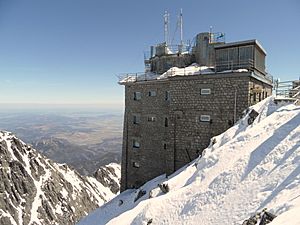
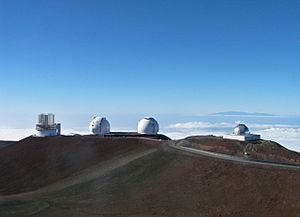
Instruments
- Telescopes are the main tool of observing. They take all the light in a big area and put in into a small area. This is like making your eyes very big and powerful. Astronomers use telescopes to look at things that are far away and dim. Telescopes make objects look bigger, closer, brighter.
- Spectrometers study the different wavelengths of light. This shows what something is made of.
- Many telescopes are in satellites. They are space observatories.
Techniques
There are way astronomers can get better pictures of the heavens. Light from a distant source reaches a sensor and gets measured, normally by a human eye or a camera. For very dim sources, there may not be enough light particles coming from the source for it to be seen. One technique that astronomers have for making it visible is using integration, (which is like longer exposures in photography).
Integration
Astronomical sources do not move much: only the rotation and movement of the Earth causes them to move across the heavens. As light particles reach the camera over time, they hit the same place making it brighter and more visible than the background, until it can be seen.
Telescopes at most observatories (and satellite instruments) can normally track a source as it moves across the heavens, making the star appear still to the telescope and allowing longer exposures. Also, images can be taken on different nights so exposures span hours, days or even months. In the digital era, digitised pictures of the sky can be added together by computer, which overlays the images after correcting for movement.
Aperture synthesis
With radio telescopes smaller telescopes can be combined together to create a big one, which works like one as big as the distance between the two smaller telescopes.
Adaptive optics
Adaptive optics means changing the shape of the mirror or lens while looking at something, to see it better.
Fields by body
Solar astronomy
Solar astronomy is the study of the Sun. The Sun is the closest star to Earth at around 92 million (92,000,000) miles away. It is the easiest to observe in detail. Observing the Sun can help us understand how other stars work and are formed. Changes in the Sun can affect the weather and climate on Earth. A stream of charged particles called the Solar wind is constantly sent off from the Sun. The Solar Wind hitting the Earth's magnetic field causes the northern lights. Studying the Sun helped people understand how nuclear fusion works.
Planetary astronomy
Planetary Astronomy is the study of planets, moons, dwarf planets, comets and asteroids as well as other small objects that orbit stars. The planets of our own Solar System have been studied in depth by many visiting spacecraft such as Cassini-Huygens (Saturn) and the Voyager 1 and 2.
Galactic astronomy
Galactic Astronomy is the study of distant galaxies. Studying distant galaxies is the best way of learning about our own galaxy, as the gases and stars in our own galaxy make it difficult to observe. Galactic Astronomers attempt to understand the structure of galaxies and how they are formed through the use of different types of telescopes and computer simulations.
Fields by electromagnetic spectrum
Radio astronomy
Magnetohydrodynamics (MHD)
Hydrodynamics is used in astronomy for mathematically modelling how gases behave. Strong magnetic fields found around many bodies can drastically change how these gases behave, affecting things from star formation to the flows of gases around compact stars. This makes MHD an important and useful tool in astronomy.
Other fields
Gravitational wave astronomy
Gravitational wave astronomy is the study of the Universe in the gravitational wave spectrum. So far, all astronomy that has been done has used the electromagnetic spectrum. Gravitational Waves are ripples in spacetime emitted by very dense objects changing shape, which include white dwarves, neutron stars and black holes. Because no one has been able to detect gravitational waves directly, the impact of Gravitational Wave Astronomy has been very limited.
Related pages
- Solar system
- Planet
- Satellite (natural) (word for moons of other planets)
- Comet
- Meteor
- Asteroid
- Star
- Black hole
- Galaxy
- Universe
- List of comets
Images for kids
-
The Paranal Observatory of European Southern Observatory is shooting a laser guide star to the Galactic Center
-
The Suryaprajnaptisūtra, a 6th-century BC astronomy text of Jains at The Schoyen Collection, London. Above: its manuscript from c. 1500 AD.
-
Greek equatorial sundial, Alexandria on the Oxus, present-day Afghanistan 3rd–2nd century BC
-
The Very Large Array in New Mexico, an example of a radio telescope
-
ALMA Observatory is one of the highest observatory sites on Earth. Atacama, Chile.
-
This image shows several blue, loop-shaped objects that are multiple images of the same galaxy, duplicated by the gravitational lens effect of the cluster of yellow galaxies near the middle of the photograph. The lens is produced by the cluster's gravitational field that bends light to magnify and distort the image of a more distant object.
-
An ultraviolet image of the Sun's active photosphere as viewed by the TRACE space telescope. NASA photo
-
The black spot at the top is a dust devil climbing a crater wall on Mars. This moving, swirling column of Martian atmosphere (comparable to a terrestrial tornado) created the long, dark streak.
See also
 In Spanish: Astronomía para niños
In Spanish: Astronomía para niños


